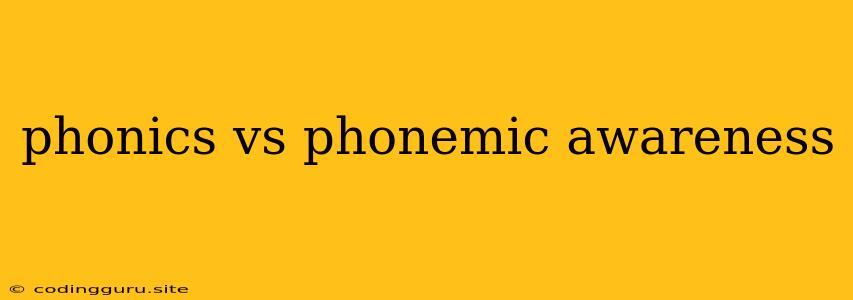Phonics vs. Phonemic Awareness: What's the Difference?
When it comes to helping children learn to read, two terms often pop up: phonics and phonemic awareness. While they sound similar, they represent different aspects of literacy development. Understanding the distinction between phonics and phonemic awareness is crucial for parents, educators, and anyone involved in early literacy instruction.
So, what exactly are these two concepts?
Phonics is a method of teaching reading that focuses on the relationship between letters and sounds. It teaches children to decode words by breaking them down into individual sounds, or phonemes, and then blending those sounds together to pronounce the word.
Phonemic awareness, on the other hand, is a cognitive skill that refers to the ability to hear and manipulate individual sounds in spoken language. It's about understanding that words are made up of smaller units of sound, and being able to identify, isolate, blend, and segment these sounds.
Let's delve a little deeper into each concept:
Phonics
Phonics is a foundational skill in reading. It teaches children to recognize letters and their corresponding sounds, enabling them to decode unfamiliar words.
Here's a simple analogy:
Imagine learning to play the piano. Phonics is like learning the notes on the keyboard and how to press the keys to produce sounds. It's the basic building block for reading.
Some key aspects of phonics instruction include:
- Letter-sound correspondence: Teaching children the sounds each letter represents.
- Blending: Combining individual sounds to create a word.
- Segmenting: Breaking a word down into individual sounds.
- Decoding: Using phonics skills to read unfamiliar words.
Examples of phonics activities:
- Sounding out words: "Cat" - /c/ /a/ /t/
- Matching letter cards to sounds: Identifying the letter "b" for the /b/ sound.
- Reading simple words: "hat," "dog," "sun"
Phonics provides a structured approach to decoding, allowing children to break down words and understand their pronunciation.
Phonemic Awareness
Phonemic awareness is a critical precursor to phonics and reading. It is the ability to hear and manipulate the sounds within words, without relying on visual cues.
Think of it this way:
Imagine you are listening to a song. Phonemic awareness is like being able to pick out the individual instruments or vocal parts within the melody. It's the ability to recognize and manipulate the sounds that make up the song.
Here are some examples of phonemic awareness activities:
- Rhyming: Identifying words that rhyme, such as "cat" and "hat."
- Blending sounds: Creating a word by blending individual sounds, such as /c/ /a/ /t/ to form "cat."
- Segmenting sounds: Breaking down a word into individual sounds, such as "cat" into /c/ /a/ /t/.
- Deleting sounds: Removing a sound from a word, such as removing the /t/ from "cat" to make "ca."
- Adding sounds: Adding a sound to a word, such as adding /t/ to "ca" to make "cat."
Phonemic awareness helps children develop an understanding of the sound structure of language, which is essential for reading and spelling.
The Relationship Between Phonics and Phonemic Awareness
Phonemic awareness lays the foundation for phonics, while phonics builds upon the skills developed through phonemic awareness.
- Phonemic awareness helps children understand the sounds that make up words, which is essential for learning phonics.
- Phonics provides a system for applying the knowledge of sounds to reading and spelling.
Think of it as a two-step process:
- Phonemic awareness: Understanding the sounds within words.
- Phonics: Learning how to decode words by applying the knowledge of sounds and letter-sound relationships.
Both phonemic awareness and phonics are crucial for developing reading fluency and comprehension.
Strategies for Developing Phonemic Awareness and Phonics
There are numerous ways to foster both phonemic awareness and phonics in children:
For Phonemic Awareness:
- Play rhyming games: "I Spy" with a rhyming focus, reading rhyming books.
- Sing songs and rhymes: "Old MacDonald Had a Farm," "Twinkle Twinkle Little Star."
- Clap out syllables: "Cat" - clap once, "Elephant" - clap twice.
- Create sound chains: Say a word and ask the child to say a word that starts with the same sound.
- Use picture cards to isolate and manipulate sounds: "Show me the picture that starts with /b/."
For Phonics:
- Use flash cards: Matching letters with their corresponding sounds.
- Read aloud and point out sounds: Focus on individual sounds within words as you read.
- Use magnetic letters: Build words and practice blending sounds.
- Create sound charts: Visual representations of letter-sound relationships.
- Play phonics games: "Sound Bingo," "Letter Match."
Conclusion
Phonemic awareness and phonics are interconnected skills that are essential for successful reading development. Phonemic awareness helps children understand the sounds within words, while phonics provides a system for decoding words using letter-sound relationships. By developing both skills, children can become confident and fluent readers. Remember, phonemic awareness is a foundational skill, and phonics builds upon that foundation. Early intervention and consistent practice are key to fostering these essential literacy skills.
